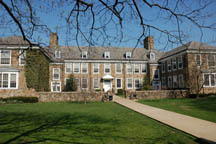WFS Community during the Global Pandemic
June 6, 2020
In the midst of the COVID-19 pandemic, community can seem like the hardest spice to live up to. Cancellations, closures, and quarantine have the potential to drive us apart, as people can no longer meet and talk to each other in person. Regardless, the Wilmington Friends School community has not dwindled in scope or significance in the face of drastically-altered normalcy. Students, faculty, family members, and staff, have all found ways to connect with each other, making the best they can of the limiting circumstances.
Earlier this spring, Hannah Carter ’22 and Aniyah Barnet ’22, wanted to help bring their grade together. Kids were feeling isolated, and in need of bonding activities, so they came up with an idea. After discussing it with Head of Upper School Rebecca Zug, they announced that they were hosting a grade-wide Kahoot during advisory. “We thought that it would be an easy and fun way to bond and learn more about each other in this pressing time,” Carter and Barnet said. The Kahoot was a great success. “It was so worth it in the end,” Barnet said. “We received many messages from students and staff saying how fun the Kahoot was, and that we should do another, or try some other form of bonding in the future.” Tenth-grade students were very appreciative of the event, and it provided an excellent opportunity to get to know each other. “It ended up being a great way to bond with one another, and to learn from each other,” said Carter. Though there hasn’t been ample opportunity to replicate the experience, the two hope to try something similar in the event that the school remains closed in September.
Many teachers have found that allowing kids to share a little community during class time goes a long way. “It’s so important to have time to share good news,” Sarah O’Brien, Upper School Chemistry teacher, said. Accelerated Chemistry classes often start with a general exchange of positive, interesting things that have happened to students in the class. Those discussions provide kids a means to share some laughter and relax a little before starting class. Most classes structure themselves this way, allowing for opportunities to trade good and exciting news, which boosts morale and enables students to feel more connected to their peers.
Every evening, Ms. O’Brien and her family put on a live concert in front of their house for their neighborhood. The performances draw substantial crowds, people who want to take the opportunity to talk with neighbors and practice community. “Yes, it’s a challenge to find new songs to learn and perform,” O’Brien commented. “But I do it because it brings joy to the community.” That joy is a force that brings people together, providing a sense of collectivity in a time of separation.
Other faculty members have been gathering together via Zoom simply to spend time away from the enormous workload that comes with remote learning. Every Friday, for example, many faculty members gather together for fellowship and to practice community. They provide a chance for faculty to relax after a stressful week. Those weeks have gotten even more tiring as students and teachers alike adjust to the idea that things may go on like this for a long time. “The first few weeks we were running on adrenaline,” Zug said. “There was a time when we realized that the sprint had become a marathon.” Even so, faculty continue to find ways to unite around a feeling of community. “The way in which faculty have connected, have bonded together, has been astounding,” Zug noted.
At school itself, the number of people regularly present has decreased dramatically. Only a skeletal staff, made up of a few administrators (such as Bill Bokowski, the associate head of school) and maintenance workers are allowed on campus. After the deep clean over spring break, around half a dozen staff necessary to the function of the school are allowed to come in on Mondays to pick up the mail, etc. Some like Bill Miller, the head of the grounds crew, have been busy making sure that the lawns are tidy, and that the area is maintained even while school is not in an in-person session. The custodial staff is also constantly cleaning the building, working hard to make sure that they and the administrators there remain healthy and safe. The building, then, is mostly silent, but the work of running the school continues both there and at home.































